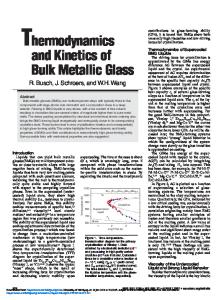Formation, Crystallization Behavior, and Soft Magnetic Properties of FeCSiBP Bulk Metallic Glass Fabricated Using Indust
- PDF / 422,419 Bytes
- 5 Pages / 593.972 x 792 pts Page_size
- 71 Downloads / 388 Views
I.
INTRODUCTION
DUE to urgent needs in energy-saving products, magnetic cores of various devices such as transformers and motors require lower loss and higher saturation magnetization. Although silicon steels are widely used due to their high saturation magnetization of about 2T, Fe-based amorphous or nanocrystalline alloys showed a great potential to replace them, because these glassy materials possess a lower core loss of about 1/5 to 1/3 that of the common silicon steel.[1–3] However, most Febased metallic glasses with good soft properties exhibit extremely low glass-forming ability (GFA), and consequently, only ribbons with thickness of about 20 lm can be fabricated, which restricts wide applications of these amorphous alloys.[2,4,5] In addition, oxygen is normally detrimental to GFA of Fe-based metallic glasses,[6,7] and therefore, high-purity elements and high vacuum and inert gas atmosphere are required for their production process, leading to high cost and low productivity. Moreover, most currently available Fe-based metallic glasses having either high GFA or good soft-magnetic properties usually contain expensive elements such as Ga, Nb, and Co,[8–10] which also result in higher raw material costs. To address the preceding problems, some researchers attempted to develop Fe-based metallic glasses using industrial raw materials. However, these alloy systems have either low GFAs[11–13] or unsatisfactory soft magnetic properties.[14–16]
H.X. LI, Lecturer, J.E. GAO, PhD Candidate, and Z.P. LU, Professor, are with the State Key Laboratory for Advanced Metals and Materials, University of Science and Technology Beijing, Beijing 100083, P.R. China. Contact e-mail: [email protected] S.L. WANG, Lecturer, and S. YI, Professor, are with the Department of Materials Science and Metallurgy, Kyungpook National University, Daegu 702-701, Korea. Manuscript submitted April 6, 2011. Article published online August 30, 2011 METALLURGICAL AND MATERIALS TRANSACTIONS A
In this study, we developed a new pseudo-binary Fe-(C-Si-B-P) bulk metallic glass (BMG) using commercial grade elements and industrial raw materials including pig-iron and P-Fe alloy. In particular, this novel Fe77.3C5.9Si3.3B4.8P8.7 glassy alloy contains no other metal elements and shows a saturation magnetization (Ms) 1.52 T, coercive force (Hc) 11.2 A/m, and a maximum attainable diameter of 2 mm for glass formation. In addition, the soft magnetic properties of the alloy can be further improved by proper annealing processes.
II. The
EXPERIMENTAL
alloy
ingots with composition Fe83.2– (x = 3.9, 5.9, and 7.9, at. pct, hereafter denoted as C3.9, C5.9, and C7.9, respectively) were prepared by arc melting a mixture of commercial grade pure elements (Fe, Si, and B > 99 wt pct) and industrial raw materials including pig-iron with a composition of (Fe79.5C18.0Si2.3P0.2, at. pct) and an Fe-P alloy in a Tigettered argon atmosphere. Cylinder samples with a diameter from 1 to 3 mm and a length of 50 mm were prepared by copper mold casting. Ribbon specimens with a width of
Data Loading...











